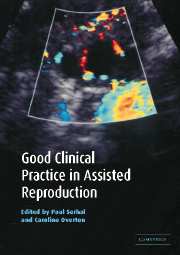Book contents
- Frontmatter
- Contents
- List of contributors
- Foreword by Bob Edwards
- Preface
- 1 Clinical assessment of the woman for assisted conception
- 2 Clinical assessment and management of the infertile man
- 3 Laboratory assessment of the infertile man
- 4 Donor insemination
- 5 Treatment options prior to IVF
- 6 Strategies for superovulation for IVF
- 7 Techniques for IVF
- 8 Ovarian hyperstimulation syndrome
- 9 Early pregnancy complications after assisted reproductive technology
- 10 Oocyte donation
- 11 Surrogacy
- 12 Clinical aspects of preimplantation genetic diagnosis
- 13 Controversial issues in assisted reproduction
- 14 Alternatives to in vitro fertilization: gamete intrafallopian transfer and zygote intrafallopian transfer
- 15 Counselling
- 16 Good nursing practice in assisted conception
- 17 Setting up an IVF unit
- 18 Information technology aspects of assisted conception
- 19 Assisted reproductive technology and older women
- 20 Ethical aspects of controversies in assisted reproductive technology
- Index
- Plate section
2 - Clinical assessment and management of the infertile man
Published online by Cambridge University Press: 22 October 2009
- Frontmatter
- Contents
- List of contributors
- Foreword by Bob Edwards
- Preface
- 1 Clinical assessment of the woman for assisted conception
- 2 Clinical assessment and management of the infertile man
- 3 Laboratory assessment of the infertile man
- 4 Donor insemination
- 5 Treatment options prior to IVF
- 6 Strategies for superovulation for IVF
- 7 Techniques for IVF
- 8 Ovarian hyperstimulation syndrome
- 9 Early pregnancy complications after assisted reproductive technology
- 10 Oocyte donation
- 11 Surrogacy
- 12 Clinical aspects of preimplantation genetic diagnosis
- 13 Controversial issues in assisted reproduction
- 14 Alternatives to in vitro fertilization: gamete intrafallopian transfer and zygote intrafallopian transfer
- 15 Counselling
- 16 Good nursing practice in assisted conception
- 17 Setting up an IVF unit
- 18 Information technology aspects of assisted conception
- 19 Assisted reproductive technology and older women
- 20 Ethical aspects of controversies in assisted reproductive technology
- Index
- Plate section
Summary
Introduction
Of the 10% of couples who are unable to conceive, approximately 20% are affected entirely by the male alone and a further 30% by a combination of male and female factors. Therefore, 50% of couples seeking treatment have a male factor as the underlying cause for their infertility.
The last two decades have seen great technological advances in the development and success of IVF techniques. As a consequence, there has been a shift in the emphasis on surgery in the treatment of male factor infertility. Many couples with causes for their infertility that are readily treatable by surgery are now referred directly for IVF.
All male patients, therefore, with infertility should be thoroughly evaluated and investigated prior to referral for assisted conception. Furthermore, they require a multidisciplinary approach in their assessment and management, involving close liaison between an andrologist, embryologist and gynaecologist, ideally working in a specialized and dedicated assisted conception unit.
This chapter deals firstly with the anatomy and physiology of male reproduction and then gives an account of the aetiology and management of male factor infertility.
Functional anatomy of the male reproductive system
The male reproductive system (Figure 2.1) consists of the penis, testes, ejaculatory ducts and accessory sex glands. The accessory sex glands comprise the prostate, seminal vesicles, Cowper's glands and glands of Littre. The accessory sex glands produce important secretions, which are required to maintain the viability of sperm in the male and female reproductive tract.
Testes
The normal human testis is approximately 15–25 ml in volume and 4.5 cm in length in the adult male. Each testis is oval in shape surrounded by a fibrous layer called the tunica albuginea (Figure 2.2).
Keywords
- Type
- Chapter
- Information
- Good Clinical Practice in Assisted Reproduction , pp. 19 - 58Publisher: Cambridge University PressPrint publication year: 2004

